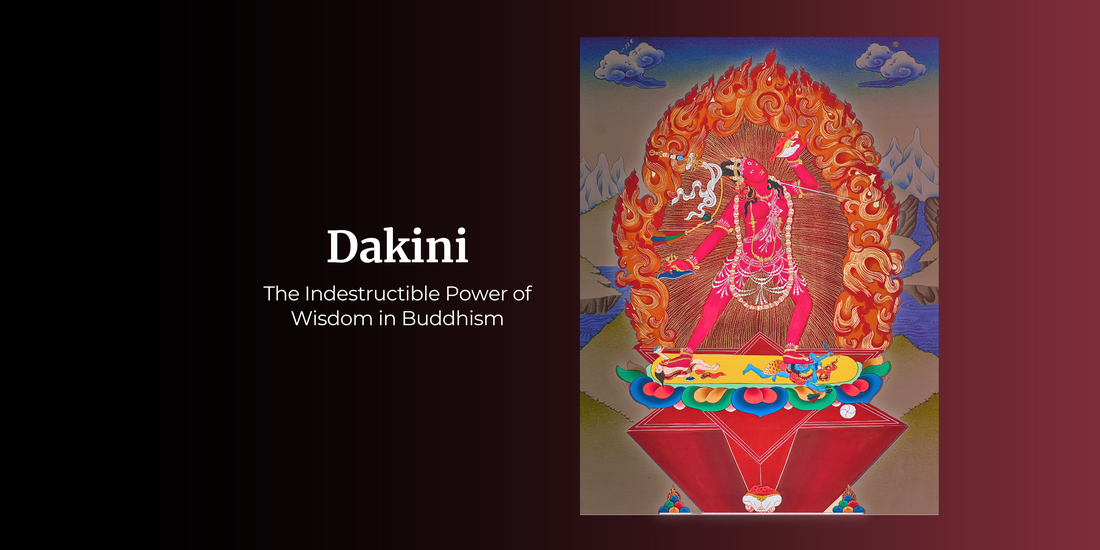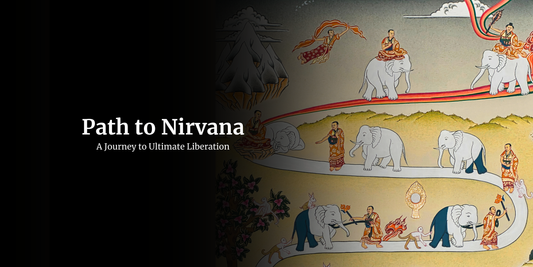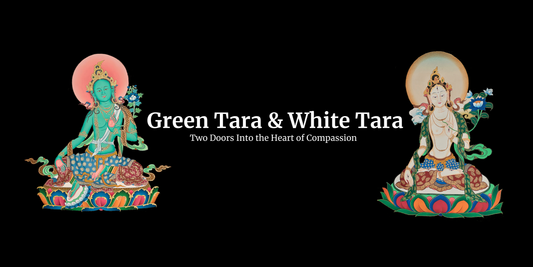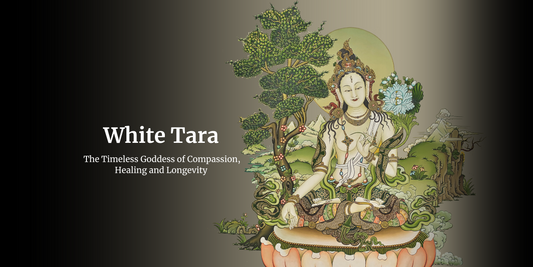- Buddhas Art of Healing
- Thangka
- Dakini: Meet the Fierce and Compassionate Female Embodiments of Awakening

Dakini: Meet the Fierce and Compassionate Female Embodiments of Awakening
Ever heard of the Dakini? In Tibetan Buddhism, she’s the sky-dancer, a mysterious, fierce, and radiant embodiment of wisdom in motion. She’s not a calm, sit-on-a-lotus kind of figure.
The Dakini is alive, untamed, and here to shake you awake. From sacred thangkas to whispered temple chants, Dakinis remind us that enlightenment can be wild, electric, and full of fire.
Curious? Let’s step into her world and meet them.
Role of Dakinis in Buddhism
Buddhist Dakinis hold a special place in Vajrayana practice. They are often seen as messengers of truth, protectors of sacred teachings, and manifestations of the enlightened mind’s wisdom aspect. Many tantric rituals, meditations, and empowerments invoke the blessing of a Dakini to help cut through confusion and ego.
Historically, some revered female practitioners, such as Yeshe Tsogyal and Machig Labdrön, were recognized as human dakini devi—to live the incarnation of this enlightened female theory.
Dakinis are not limited to a single form or role; they are fluid, transformative, and free from conventional boundaries.
|
Term |
Meaning |
|
Dakini (Khandra) |
Sky-goer or sky-dancer, representing wisdom in action |
|
Buddhist Dakinis |
A spiritual guide, protector, and messenger of truth |
|
Dakini Devi |
A revered manifestation of enlightened feminine energy |
|
Wrathful Dakinis |
Fierce form that destroys ignorance and protects the Dharma |
|
Peaceful Dakinis |
Gentle form that offers blessings, compassion, and inspiration |
In her peaceful aspect, the Dakini goddess appears adorned with offerings of flowers, jewels, and bowls. In her wrathful aspect, she dances between flames, performing ritual to cut through ignorance with fearless compassion
Peaceful and Wrathful Dakini Forms
Dakinis are not always portrayed as serene. In many thangkas, they appear with wild hair, dancing flames, and skull jewelry—expressing fierce compassion that destroys ignorance. These angry forms are not violent to harm but to save religion and awaken practitioners quickly.
Other illustrations show them adorned with flowers, offering wisdom nectar, or surrounded by vibrant light—a soft reminder of the joy and beauty of the awakened state.
|
Form |
Appearance |
Symbolic Meaning |
|
Peaceful Dakini |
Gentle smile, flowing silk garments, lotus offerings |
Compassion, blessings, inspiration |
|
Wrathful Dakini |
Fierce gaze, flames, skull ornaments, wild hair |
Fierce compassion, removal of ignorance, rapid awakening |
These adverse forms reflect a deep truth in Buddhism—depending on what is necessary for liberation, wisdom can be soft and nurturing or intense and transformative.
In the Vajrayana tradition, Buddhist Dakinis are more than artistic symbols—they are guides, protectors, and catalysts for awakening.
Their main roles include:
- Transmission of Knowledge: Distributing intensive teachings through subtle or visionary methods
- Guard of Religion: To preserve the purity of Buddhist practice
- Catalyst for Change: Using compassion or fierce methods to help practitioners break through ego-clinging.
Some Dakinis in our Thangka Collection
1. Kurukulla Dakini
The red goddess of magnetizing energy, Kurukulla, enchants, draws in, and subdues negative forces. Depicted holding a bow and arrow made of flowers, she works to attract positive conditions and beneficial connections. Symbolizes the power of attraction, influence, and transformation through compassion and wisdom.

Bring Kurkulla energy into your space. Explore our Kurukulla Thangkas.
2. Vajrayogini
The supreme queen of Dakinis—blazing red, semi-wrathful, dancing in flames of wisdom. She is the embodiment of ultimate insight and bliss, guiding practitioners to swift enlightenment. Represents the union of bliss and emptiness, cutting through ego and illusion.

Experience the transformative power of Vajrayogini. Discover our Vajrayogini thangka collections.
3. Vajravarahi
The Diamond Sow Dakini—fierce, vibrant, and victorious over illusion. She dances atop a corpse, wielding a curved knife and skull cup, cutting away ignorance. Embodies indestructible wisdom and the transformation of negative emotions into enlightened energy.

Channel Vajravarahi’s indestructible wisdom. Browse our Vajravarahi thangka collection.
Dakini in Art and Symbolism
In Tibetan thangka painting, each detail of a Dakini’s image carries meaning. Her dance reflects the ever-changing, impermanent nature of life. Her naked form represents complete openness and truth, free from concealment. The skull cup (kapala) she sometimes holds signifies the transformation of negative emotions into wisdom.
Collectors and practitioners treasure Dakini thangkas not only as art but also as spiritual companions—constant reminders of clarity, freedom, and fearlessness
The Spirit of the Dakini in Modern Practice
Whether it is imagined in meditation, honored through rituals, or appreciated in holy art, she inspires courage to face the truth. Her terrible grace teaches that awakening is not always comfortable, but it is always liberating.
For many people, association with a Dakini Devi is a way to adopt both knowledge and compassion in everyday life.
In short, Dakini is not just a mysterious figure of the past—she is a living power that asks us to get up beyond the boundaries and dance in the open sky of awareness and embodies the fearless bliss of an awakened heart.

1. What is the meaning of "Dakini" in Buddhism?
A Dakini is an embodiment of enlightened feminine wisdom, known as khandro in Tibetan, meaning “sky-dancer” or “sky-goer.”
2. Are Dakinis only female?
While traditionally represented as female, Dakinis represent a principle of wisdom-energy that transcends gender.
3. What is the role of a Buddhist Dakini?
She guides practitioners, protects the Dharma, and embodies wisdom in its most dynamic form.
4. Are Dakinis real beings or symbolic?
In Vajrayana Buddhism, they can be both—real visionary guides and symbolic representations of inner wisdom.
5. What is the difference between peaceful and wrathful Dakinis?
Peaceful forms inspire and bless, while wrathful forms cut through ignorance with fierce compassion.
Bringing the Dakini Energy into Your Life
You can connect with Dakini energy through:
- Meditation practices that visualize the Dakini in peaceful or wrathful form.
- Sacred art, such as hand-painted Dakini thangkas, to inspire your space.
-
Mantra recitation and study of Dakini teachings.
Invite the Wisdom of the Dakini. If the fierce grace of the Dakini goddess speaks to your heart, explore our collection of Dakini and Buddhist thangkas—each hand-painted with devotion, carrying the blessings of this timeless wisdom.
Bring home a sacred reminder that liberation is not far away—it’s already dancing in the open sky of your mind.
These qualities come alive in iconic figures like Vajravarahi, whose thangka in our Dakinis & Yoginis collection radiates sharp clarity and transformative power—and even helps cut through mental fog. Buddha's Art of Healing



